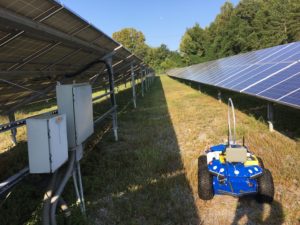Facts, Figures, and Findings from EPRI Research, Reports, and Other Sources

A survey of recycling companies points to a critical trade-off in recycling of solar photovoltaic (PV) modules. On one hand, greater recovery of valuable trace constituents such as silver can reduce lifetime environmental impacts of solar generation and make module recycling more economically viable. On the other hand, it also requires more process steps and energy consumption. To be successful, the nascent PV recycling industry will need to strike a happy medium. That said, as processes and technologies for PV module recycling advance, it may be possible to increase recovery of materials while reducing energy use. While the massive growth ...
Read More
Read More

‘Sol-Gel’ Technology Could Offer Lower Cost, More Rugged Solution for Component Monitoring
Soon, it may be possible to spray or paint an ultrasonic sensor on power plant components for tracking their degradation and structural health. An EPRI study reports that the “sol-gel” coating is ready for initial field testing. Traditionally, workers scan plant components periodically with handheld ultrasonic sensors. This approach is costly, and comparing inspection results can be hampered by discrepancies in the sensor’s position or orientation. With sol-gel technology, a chemical slurry is applied and sintered onto a component, forming a film on its surface. An electric ...
Read More
Soon, it may be possible to spray or paint an ultrasonic sensor on power plant components for tracking their degradation and structural health. An EPRI study reports that the “sol-gel” coating is ready for initial field testing. Traditionally, workers scan plant components periodically with handheld ultrasonic sensors. This approach is costly, and comparing inspection results can be hampered by discrepancies in the sensor’s position or orientation. With sol-gel technology, a chemical slurry is applied and sintered onto a component, forming a film on its surface. An electric ...
Read More

Study: Leading Forecast Providers Have Average Error of 5–6%
The overall accuracy of solar power forecasts is improving, though performance varies among products and can diminish during periods with high variability in solar output, according to an EPRI study. Grid operators use these forecasts for dispatching other system resources more effectively. But forecasting is still an emerging technology. Complex modeling must account for numerous factors, including historical weather, irradiance reaching solar panels, energy production data, solar panel efficiency, and weather forecasts. In collaboration with Southern Company, EPRI conducted a six-month evaluation of 10 commercial forecast providers at four solar ...
Read More
The overall accuracy of solar power forecasts is improving, though performance varies among products and can diminish during periods with high variability in solar output, according to an EPRI study. Grid operators use these forecasts for dispatching other system resources more effectively. But forecasting is still an emerging technology. Complex modeling must account for numerous factors, including historical weather, irradiance reaching solar panels, energy production data, solar panel efficiency, and weather forecasts. In collaboration with Southern Company, EPRI conducted a six-month evaluation of 10 commercial forecast providers at four solar ...
Read More

Study: Cooling Technology Can Tap Enormous Efficiency Potential of United States’ 2.5 Million Small Data Centers
Variable refrigerant flow (VRF) heat pumpsVariable refrigerant flow (VRF) heat pumps can reduce energy use in small data centers by up to 29%, according to an EPRI study. While companies such as Google, Facebook, and Apple apply significant resources to reduce the massive energy consumption of their warehouse-scale data centers, the 2.5 million small data centers in the United States present enormous untapped efficiency potential. Representing about 1% of total U.S. electricity consumption, these network closets and server rooms are often located in ...
Read More
Variable refrigerant flow (VRF) heat pumpsVariable refrigerant flow (VRF) heat pumps can reduce energy use in small data centers by up to 29%, according to an EPRI study. While companies such as Google, Facebook, and Apple apply significant resources to reduce the massive energy consumption of their warehouse-scale data centers, the 2.5 million small data centers in the United States present enormous untapped efficiency potential. Representing about 1% of total U.S. electricity consumption, these network closets and server rooms are often located in ...
Read More

In field tests at the 1-megawatt Strawberry Plains solar power plant, an EPRI-developed robot demonstrated its ability to navigate rough terrain autonomously and collect accurate data on electromagnetic interference. Interference radiating from power electronics in large solar arrays may violate Federal Communications Commission regulations. To assess its strength and source, it’s necessary to gather, store, and analyze large amounts of data. Known as the “Big, Autonomous, Mobile Measurement Platform” (BAMMP), the robot measures 42 inches by 33 inches by 20 inches, with four large wheels and a platform for various sensors (see photo above). Operators control it remotely via an ...
Read More
Read More

